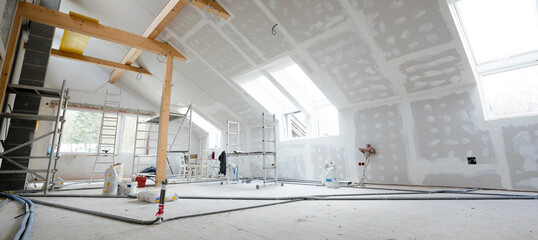When it comes to creating smooth, durable, and visually appealing interiors, drywall is one of the most widely used building materials. Known for its versatility, cost-effectiveness, and ease of installation, drywall has become a standard choice for homeowners, contractors, and builders alike. Whether you are constructing a new property or renovating an existing one, understanding the benefits and uses of drywall can help you achieve flawless results in your living or working spaces.

What Makes Drywall So Popular
Drywall is a preferred material because it balances functionality with affordability. Unlike older methods that involved applying multiple layers of plaster, drywall provides a quicker and more efficient way to achieve smooth walls and ceilings. It is lightweight, easy to cut, and can be installed in large panels, which reduces both labor and time.
Another major advantage of drywall is its versatility. It can be painted, textured, or finished in various ways, making it suitable for a wide range of interior design styles. From modern minimalism to classic elegance, drywall adapts to nearly any aesthetic vision.
Key Benefits of Drywall
Drywall offers a long list of benefits that make it a go-to option in construction and remodeling:
- Cost-Effective – One of the most affordable wall and ceiling solutions.
- Fire Resistance – Many types of drywall provide added fire protection, enhancing safety in homes and commercial buildings.
- Energy Efficiency – Helps with insulation and maintaining consistent indoor temperatures.
- Noise Reduction – Specialized soundproof drywall helps reduce noise transfer between rooms.
- Easy Installation and Repair – Quick to install and simple to patch if damaged.
- Smooth Finishes – Creates clean, even surfaces for painting or wallpapering.
These benefits make drywall a practical choice for nearly every type of construction project.
Common Uses of Drywall
Drywall is not limited to walls alone. It is widely used in different areas of interior construction, including:
- Walls – The most common use is to provide a smooth surface for finishing.
- Ceilings – Helps conceal wiring, insulation, and ductwork while offering a polished look.
- Partitions – Perfect for dividing spaces and creating new rooms without permanent structures.
- Design Features – Used in creating arches, niches, and decorative elements.
Its adaptability makes drywall suitable for residential, commercial, and industrial projects.
Different Types of Drywall
Not all drywall is the same, and choosing the right type ensures better performance. Some common variations include:
- Regular Drywall – Standard option for most interior walls.
- Moisture-Resistant Drywall – Ideal for bathrooms, kitchens, and laundry areas where humidity is higher.
- Fire-Resistant Drywall – Provides added protection in areas where fire safety is crucial.
- Soundproof Drywall – Reduces noise transmission between rooms.
- Impact-Resistant Drywall – Stronger panels designed for high-traffic or vulnerable areas.
Selecting the right type of drywall ensures durability and functionality tailored to specific needs.
The Drywall Installation Process
Installing drywall may look straightforward, but it requires skill for a professional finish. The basic process involves:
- Measuring and Cutting – Panels are measured and cut to fit the wall and ceiling dimensions.
- Framing Preparation – Drywall sheets are attached to wooden or metal studs.
- Securing Panels – Panels are screwed or nailed securely in place.
- Taping Joints – Special tape is applied over seams to create a seamless surface.
- Applying Joint Compound – Multiple layers of compound are spread and sanded for smoothness.
- Finishing Touches – Walls are primed and painted or decorated according to design preferences.
Professional installation ensures that seams are invisible, surfaces are smooth, and walls are ready for finishing.
Maintaining and Repairing Drywall
Although drywall is durable, it is not immune to damage. Small dents, cracks, and holes may occur over time. The good news is that drywall is relatively easy to repair compared to other materials. Minor holes can be patched with joint compound, while larger damage may require replacing a section of drywall.
To maintain drywall, avoid exposing it to excess moisture, which can weaken the panels and lead to mold growth. Regular inspections for cracks or water stains help identify issues early before they worsen.
Drywall and Interior Design
Drywall plays a major role in modern interior design. It provides a blank canvas that allows homeowners and designers to explore endless creative possibilities. Whether you want smooth painted walls, textured finishes, or patterned wallpaper, drywall makes it possible.
Additionally, drywall can be used to add unique design features like recessed lighting areas, accent walls, and custom niches. This flexibility makes it one of the most design-friendly construction materials available.
Eco-Friendly Advantages of Drywall
Sustainability is an important consideration in modern construction, and drywall offers several eco-friendly benefits. Many drywall products are made from recycled materials, reducing waste and environmental impact. Additionally, drywall is energy-efficient, helping regulate indoor temperatures and reducing heating and cooling costs.
When removed, old drywall can often be recycled into new panels, further minimizing waste. Choosing drywall with eco-friendly features supports a greener approach to building and remodeling.
Why Professional Drywall Services Matter
While some homeowners attempt drywall installation as a DIY project, professional expertise often delivers better results. Skilled installers ensure precise measurements, seamless finishes, and long-lasting durability. Professionals also have the tools and techniques needed to handle larger projects efficiently and safely.
Relying on experienced services saves time, reduces costly mistakes, and ensures that walls and ceilings meet both functional and aesthetic standards.
Drywall has become the foundation of modern interiors because of its affordability, adaptability, and ease of installation. It provides smooth, durable surfaces that enhance both the beauty and functionality of any space. From standard walls to creative design features, drywall makes it possible to achieve stunning results while staying within budget.
Whether you are building, remodeling, or simply updating your space, drywall remains a practical and reliable choice. With proper installation, maintenance, and creative finishing, it ensures that your walls and ceilings not only look great but also stand the test of time.